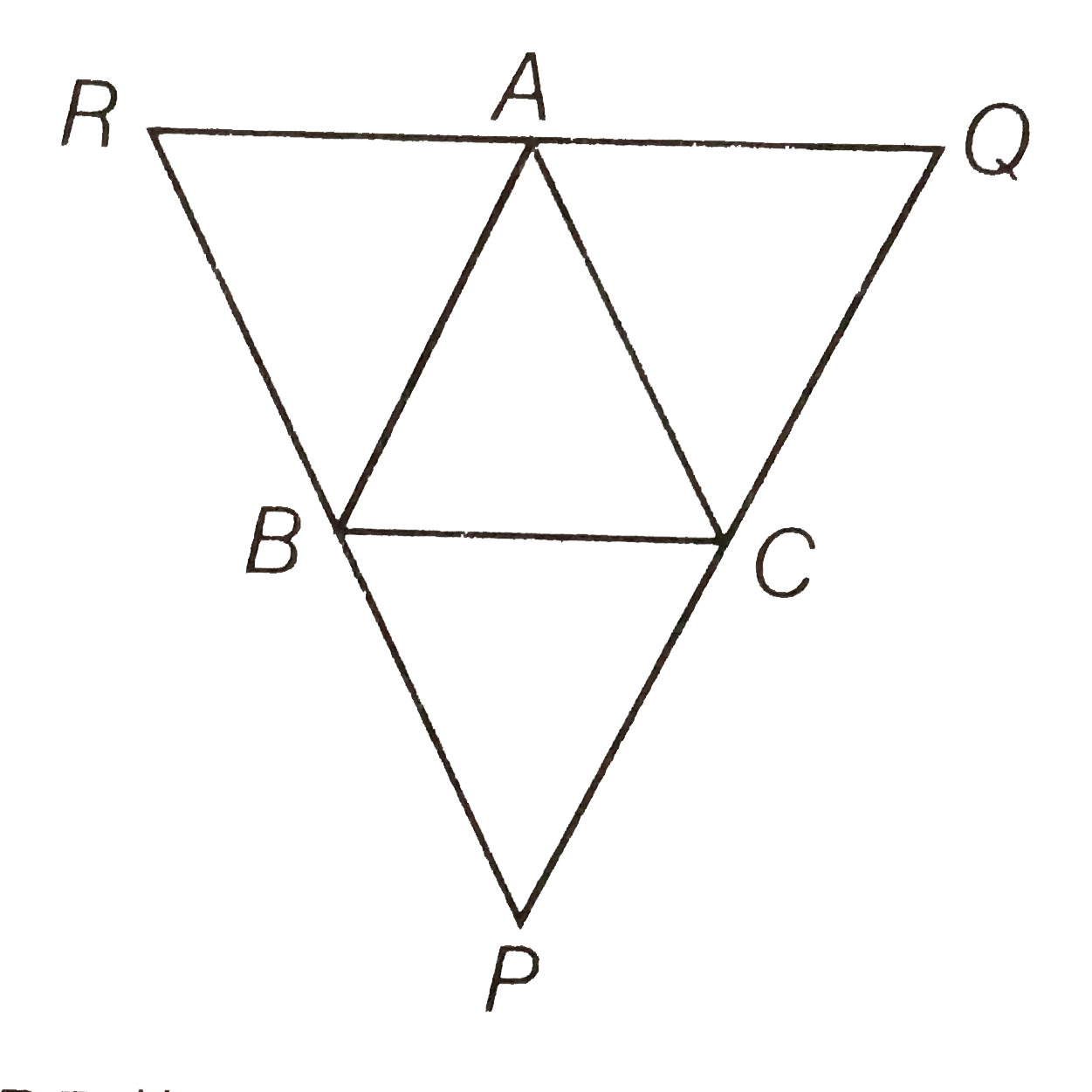Let A, B, C respresent the vertices of a triangle, where A is the origin and B and C have position b and c respectively. Points M, N and P are taken on sides AB, BC and CA respectively, such that (AM)/(AB)=(BN)/(BC)=(CP)/(CA)=alpha Q. AN+BP+CM is
a. 3α(b+c)
b. α(b+c)
c. (1−α)(b+c)
d. 0
The correct Answer is:D
To solve the problem, we need to find the expression for →AN+→BP+→CM given the conditions about the points M,N,P on the triangle formed by vertices A,B,C.
Step 1: Define the Position Vectors
Let:
- →A=→0 (the origin),
- →B=→b,
- →C=→c.
Step 2: Find the Position Vector of Point M
Since M is on side AB such that AMAB=α, we can express the position vector of M as:
→M=(1−α)→A+α→B=(1−α)→0+α→b=α→b.
Step 3: Find the Position Vector of Point N
Since N is on side BC such that BNBC=α, we can express the position vector of N as:
→N=(1−α)→B+α→C=(1−α)→b+α→c.
Step 4: Find the Position Vector of Point P
Since P is on side CA such that CPCA=α, we can express the position vector of P as:
→P=(1−α)→C+α→A=(1−α)→c+α→0=(1−α)→c.
Step 5: Calculate →AN+→BP+→CM
Now we can compute each vector:
- →AN=→N−→A=→N=(1−α)→b+α→c,
- →BP=→P−→B=(1−α)→c−→b,
- →CM=→M−→C=α→b−→c.
Now, we add these vectors together:
→AN+→BP+→CM=((1−α)→b+α→c)+((1−α)→c−→b)+(α→b−→c).
Step 6: Simplify the Expression
Combining the terms:
=(1−α)→b+α→c+(1−α)→c−→b+α→b−→c.
Grouping similar terms:
=((1−α)−1+α)→b+(α+(1−α)−1)→c.
This simplifies to:
=0⋅→b+0⋅→c=→0.
Conclusion
Thus, we find that:
→AN+→BP+→CM=→0.
Let:
- →A=→0 (the origin),
- →B=→b,
- →C=→c.
Since M is on side AB such that AMAB=α, we can express the position vector of M as:
→M=(1−α)→A+α→B=(1−α)→0+α→b=α→b.
Since N is on side BC such that BNBC=α, we can express the position vector of N as:
→N=(1−α)→B+α→C=(1−α)→b+α→c.
Since P is on side CA such that CPCA=α, we can express the position vector of P as:
→P=(1−α)→C+α→A=(1−α)→c+α→0=(1−α)→c.
Now we can compute each vector:
- →AN=→N−→A=→N=(1−α)→b+α→c,
- →BP=→P−→B=(1−α)→c−→b,
- →CM=→M−→C=α→b−→c.
→AN+→BP+→CM=((1−α)→b+α→c)+((1−α)→c−→b)+(α→b−→c).
Combining the terms:
=(1−α)→b+α→c+(1−α)→c−→b+α→b−→c.
Grouping similar terms:
=((1−α)−1+α)→b+(α+(1−α)−1)→c.
This simplifies to:
=0⋅→b+0⋅→c=→0.
Thus, we find that:
→AN+→BP+→CM=→0.
Topper's Solved these Questions
- PRODUCT OF VECTORSBOOK - ARIHANT MATHS ENGLISHCHAPTER - PRODUCT OF VECTORSEXERCISE - Exercise For Session 1
12 Videos
- PRODUCT OF VECTORSBOOK - ARIHANT MATHS ENGLISHCHAPTER - PRODUCT OF VECTORSEXERCISE - Exercise For Session 2
18 Videos
- PRODUCT OF VECTORSBOOK - ARIHANT MATHS ENGLISHCHAPTER - PRODUCT OF VECTORSEXERCISE - Exercise (Questions Asked In Previous 13 Years Exam)
51 Videos
- PROBABILITYBOOK - ARIHANT MATHS ENGLISHCHAPTER - PROBABILITYEXERCISE - Exercise (Questions Asked In Previous 13 Years Exam)
54 Videos
- PROPERTIES AND SOLUTION OF TRIANGLES BOOK - ARIHANT MATHS ENGLISHCHAPTER - PROPERTIES AND SOLUTION OF TRIANGLES EXERCISE - Exercise (Questions Asked In Previous 13 Years Exam)
21 Videos
Similar Questions
Let A, B, C represent the vertices of a triangle, where A is the origin and B and C have position b and c respectively.* Points M, N and P are taken on sides AB, BC and CA respectively, such that AMAB=BNBC=CPCA=α . If △ represent the area enclosed by the three vectors AN, BP and CM, then the value of α, for which △ is least
View SolutionThevertices of a triangle ABC are A(−7,8),B(5,2)andC(11,0). If D, E, F are the mid-points of the sides BC,CAandAB respectively, show that ΔABC=4ΔDEF.
View SolutionIn a triangle ABC , let P and Q be points on AB and AC respectively such that PQ∣∣BC . Prove that the median AD bisects PQ.
View SolutionThrough A, B and C lines RQ, PR and QP have been drawn, respectively parallel to sides BC, CA and AB of a ΔABC as shown in figure. Show that BC=12QR.

View SolutionD, E and F are the mid-points of the sides BC, CA and AB respectively of triangle ABC. Prove that:
BDEF is a parallelogram.
View SolutionThe three vectors a, b and c with magnitude 3, 4 and 5 respectively and a+b+c=0, then the value of a.b+b.c+c.a is
View SolutionConsider △ABC Let I be the incentre and a,b c be the sides of the triangle opposite to the angle A,B,C respectively. Let O be any point in the plane of △ABC within the triangle . AO ,BO ,CO meet the sides BC, CA and AB in D, E and F respectively then ODAD+OEBE+OFCF=
View SolutionIn a ΔABC,D,EandF are respectively the mid-points of BC, CA and AB. If the lengths of side AB, BC and CA are 7 cm, 8 cm and 9 cm respectively, find the permeter of ΔDEF.
View SolutionLet →a,→b,→c represent respectively −−→BC,−−→CAand−−→AB where ABC is a triangle , Then ,
View SolutionA (-4, 2), B(0, 2) and C(-2,-4) are vertices of a triangle ABC. P, Q and R are mid-points of sides BC, CA and AB respectively. Show that the centroid of Δ PQR is the same as the centroid of Δ ABC.
View Solution
